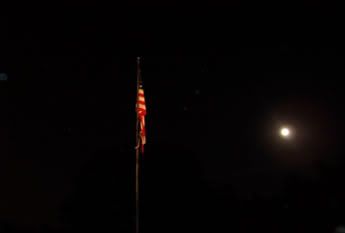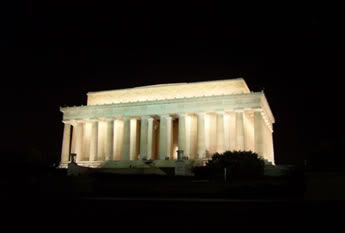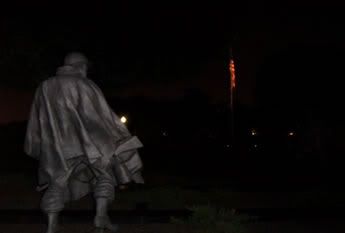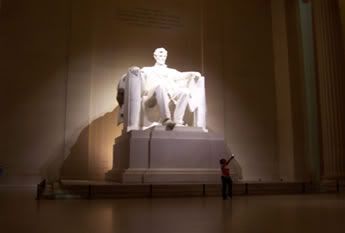
After the baseball game I got the Metro back from RFK and had a wander about some of the Mall's sights lit up at night. The relentless heatwave that had gripped the East Coast had subsided a little, but it was still muggy and sticky, even that late. The sites on the Mall were all still busy, plenty of tourists wandering about looking at the monuments and buildings. Each one had a compliment of bored-looking security guards, most of whom were sitting in un-airconditioned huts listening to loud sports radio programmes. I walked past the State Department and one of the gun-toting guards nodded at me in greeting before flinching as a rat scampered across the pavement. "Man, there'all kind of rats in them bushes," he said. "Dang things."

The Lincoln Memorial glowing in the dark, more peaceful without the droning aeroplanes overhead. There are 36 Doric columns on the outside, representing the number of States in the Union at the time of his death. John Wilkes Booth had originally planned to kidnap the President in exchange for the release of Confederate prisoners, but an anti-slavery speech Lincoln gave in early April 1865 enraged him so much he decided assassinate him instead. On April 14th, Ford's Theatre was showing a production of 'Our American Cousin' when Booth crept up behind Lincoln and shot him in the back of the head at point blank range. In a US TV poll in 2005, Lincoln was voted the second Greatest American in history, behind Ronald Reagan.

Ghostlike statue making up the Korean War Memorial, to the 1.5 million American men and women who served in what has become known as the 'Forgotten War', due to the prominance of WWII and the Vietnam conflict. Lasting slightly over three years at the start of the 1950's, the war arose from the division of the Korean peninsula in 1945 before the official surrender of the occupying Japanese. The Soviet Union invaded from the North, halting at the 38th Parallel where the Americans had advanced from the South. Both Allied forces wanted the Japanese to surrender to them, so they ended up signing two peace deals for each half of the now divided country. Each 'liberating' force installed a Government sympathetic to their ideals. Both then left in 1949, leaving the peninsula locked in two fiercely opposing camps.

A girl takes her photo with Abe sitting on his marble throne. Undoubtedly his early death made Lincoln a martyr for the anti-slavery cause, and to future generations who despise the idea of forced labour his visions have made him a legendary figure. His birthplace and family home are historic memorials, as are New Salem (a reconstruction of the town where he lived as a youngster), and Ford's Theatre and the house over the road where he eventually died. He has many cities and counties named after him in America, as well as the Lincoln Automobile. He is represented on the $5 bill, one cent coin, and of course has his angular face chiselled into the side of Mount Rushmore, South Dakota.

This is the view in the other direction, with people sitting on the Memorial steps looking out towards the Washington Monument reflected in the long slender pool of the Mall. The reflection is chopped off at the bottom because of the low wall that runs around the roundabout isolating Lincoln's temple. The small ring of lights at the base is the WWII Monument, midway between the two. Although it all looks close together, the memorials to the two greatest American presidents (if you ignore Reagan - who has a nearby airport named after him) are almst 2km apart.